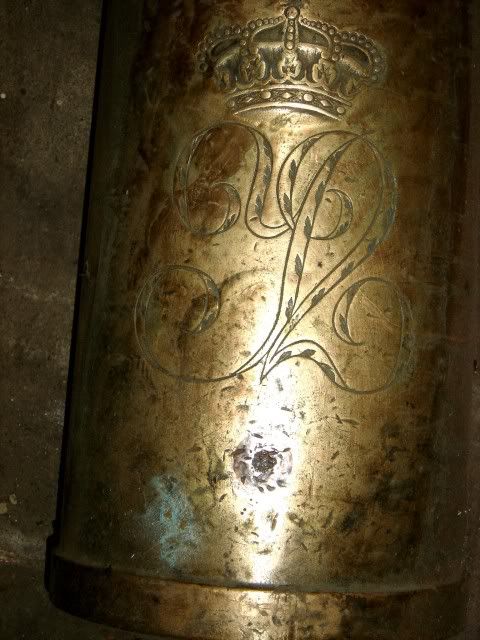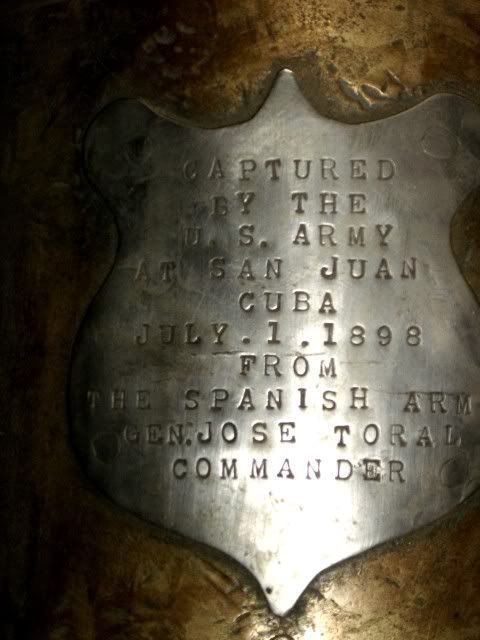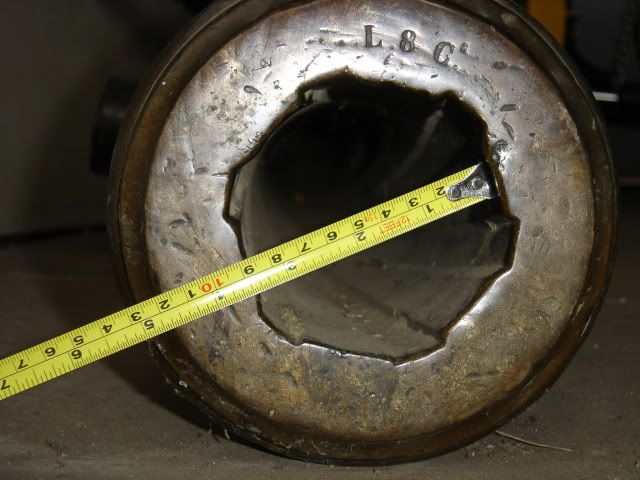British Ordnance Collectors Network
You are using an out of date browser. It may not display this or other websites correctly.
You should upgrade or use an alternative browser.
You should upgrade or use an alternative browser.
Dynamite Gun in Cuba
- Thread starter Gspragge
- Start date
Hi
here an other picture from this link The Battle of San Juan Hill.
http://www.go2gbo.com/forums/index.php?topic=135600.0

*******************************************************************
FROM
http://www.spanamwar.com/dynamite.htm
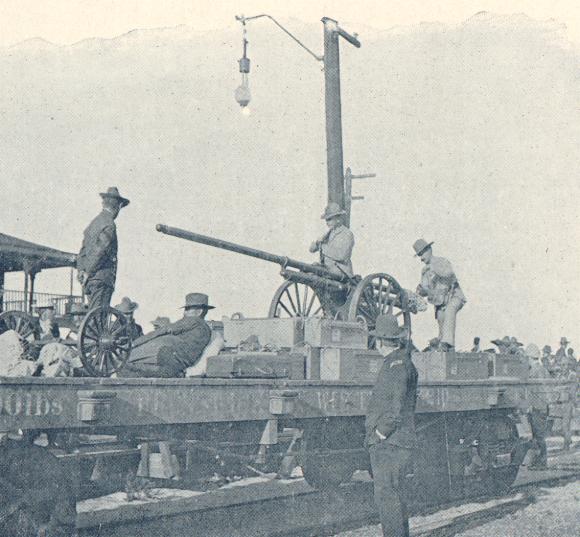
[h=3]GENERAL:[/h]The Sims-Dudley dynamite gun was an experimental breechloading artillery piece that used compressed air to launch a projectile containing gelatinous "dynamite". This unusual gun saw use with Theodore Roosevelt's Rough Riders.[h=3]BACKGROUND:[/h]The Dudley-Sims dynamite gun was a smaller version with slightly different mechanics, but was based on a concept developed by D. M. Medford of Chicago, Illinois. The guns did not fire or utilize dynamite, therefore the name is really incorrect. Medford's large gun used compressered air, supplied by compressors, to launch its shells. The Dudley-Sims field gun could not carry a compressor, so, instead, it used a small black powder charge to compress the air needed to fir the projectile. The projectile was not loaded with dynamite but with nitro-based gelatin and fitted with either a time or a percussion fuze.The Sims-Dudley dynamite gun actually saw use in Cuba prior to the Spanish American War. The Cuban insurgent forces had one of these artillery pieces in their arsenal. They were fired in combat for the first time on August 28, 1897 in an attack on the Spanish-held town of Victoria de las Tunas. Frederick Funston, later a general butthen serving as a major with the Cuban Insurgents, described its first shot as follows: "There was no little uneasiness as to what would happen when the uncanny weapon was fired, and there was not much of a tendency to stand too close to it. When the lanyard was pulled the gun gave what sounded like a loud cough and jumped a little" launching its projectile against a brick wall five hundred yards away creating a hole large enough to drive a "good-sized truck" through and sending a cloud of dust debris fifty feet high. In general, the Cuban Insurgents had good success with the weapon.
The U.S. government purchased sixteen of the Sims-Dudley field pieces for use by the U.S. Army. Along with the guns, the Army received one hundred rounds of ammunition per gun.
The Rough Riders also had some experience with the dynamite gun. One of the guns was present at San Juan Hill, but it was not used since the ammuntion had been misplaced, and was later found in a medical aid station. The guns did see use in the siege of Santiago. Theodore Rooseveltgave a quite different report from that of Funston and the Cuban Insurgents. He reported that the gun was subject to breakdown, had poor range and little penetrating power. The Rough Riders used the gun while in the trenches at Santiago. Theodore Roosevelt related : "...it was used as a like a mortar from behind the hill, it did not betray its presence, and those firing it suffered no loss. Every few shots it got out out of order and theRough Rider machinists....would spend an hour or two setting it right."
The government intended to send all sixteen of its dynamite guns to Cuba, but the plans were never put into effect. Some were, however, sent toPuerto Rico. The 4th Ohio Volunteer Infantry's Dynamite Gun Detachment, used the guns near the town of Guayama. Five shots were fired, with the desired effect of quieting the Spanish gunfire realized.
The parallel development of high explosives and the inherent problems of the dynamite guns lead to the demise of the dynamite guns. By 1900, the dynamite guns were deemed "not acceptable" by the U.S. Army and all of the Sims-Dudley guns were out of operation by the end of the decade. The guns were considered obsolete and sold as surplus. Dynamite guns had shown themselves impractical.
One of the guns ended up in the possession of arms dealer Francis Bannerman of new York. During a parade while on a visit to New York after his African expedition, Theodore Roosevelt spotted the gun in a display. As the parade passed the gun, Roosevelt's eyes were fixed on the gun, and he led his Rough Riders in a cheer for the weapon, perhaps forgetting some of his earlier comments in his nostalgia.
One of the Dynamite guns remains today, on San Juan Hill in Cuba. Another is in a museum in Havana.
[h=3]ADVANTAGES/DISADVANTAGES:[/h]The problems inherent in the novel Sims-Dudley dynamite gun far outweighed its advantages.The gun did have several advantages over other artillery used by the United States forces in Cuba. First, it used compressed air to fire its shells. As a result, when fired there was no smoke to give away its position and result in a bombardment by the enemy. The quietness of the gun would also aid in this respect. The compression charge, however, did create some smoke.
Secondly, the gun had a strong psychological effect on the enemy because of its highly explosive projectile, making the weapon basically a terror weapon. The shock was unusual enough that, after a shot from the gun, Roosevelt reported that the Spaniards in the trenches showed themselves, making themselves targets for other weapons.
However, the disadvantages were greater. Because of the slow muzzle velocity, high gun tube elevation was required unless fired at very short range. The projectile itself had a tendency to be deflected by the wind, limiting the accurate range of the gun. It was not reliable at ranges over 900 yards, which was somewhat limiting. The gun was reported to jam easily, and required several hours work after a few shots before it could be fired again.
The dynamite explosive lacked the shattering power of a standard projectile, and was also sensitive to freezing and bullet impact. The projectiles were fragile and had an usual fuze which frequently would not detonate. The fuze consisted of a steel ball that impacted a series of percussion primers when the projectile hit the target. The projectile was armed in flight when an impeller unscrewed the end of the fuze, freeing the ball. The system, when it operated correctly, created an unnerving six or seven second delay between impact and explosion.
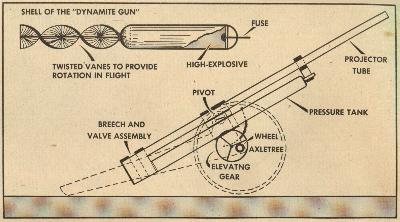
Range:900 yards effective (according to Funstan)
Muzzle velocity:600 feet per second"
Blank" air compression charge:7 to 9 ounces
Weight, complete with carriage:1000 pounds
Length, complete with carriage:14 feet
Total weight of cartridge:10 pounds
Total length of cartridge:18 inches
Diameter of cartridge:2.5 inches
Bursting-charge, common shell:5 pounds of nitro-gelatine
====================
here an other picture from this link The Battle of San Juan Hill.
http://www.go2gbo.com/forums/index.php?topic=135600.0
*******************************************************************
FROM
http://www.spanamwar.com/dynamite.htm
[h=3]GENERAL:[/h]The Sims-Dudley dynamite gun was an experimental breechloading artillery piece that used compressed air to launch a projectile containing gelatinous "dynamite". This unusual gun saw use with Theodore Roosevelt's Rough Riders.[h=3]BACKGROUND:[/h]The Dudley-Sims dynamite gun was a smaller version with slightly different mechanics, but was based on a concept developed by D. M. Medford of Chicago, Illinois. The guns did not fire or utilize dynamite, therefore the name is really incorrect. Medford's large gun used compressered air, supplied by compressors, to launch its shells. The Dudley-Sims field gun could not carry a compressor, so, instead, it used a small black powder charge to compress the air needed to fir the projectile. The projectile was not loaded with dynamite but with nitro-based gelatin and fitted with either a time or a percussion fuze.The Sims-Dudley dynamite gun actually saw use in Cuba prior to the Spanish American War. The Cuban insurgent forces had one of these artillery pieces in their arsenal. They were fired in combat for the first time on August 28, 1897 in an attack on the Spanish-held town of Victoria de las Tunas. Frederick Funston, later a general butthen serving as a major with the Cuban Insurgents, described its first shot as follows: "There was no little uneasiness as to what would happen when the uncanny weapon was fired, and there was not much of a tendency to stand too close to it. When the lanyard was pulled the gun gave what sounded like a loud cough and jumped a little" launching its projectile against a brick wall five hundred yards away creating a hole large enough to drive a "good-sized truck" through and sending a cloud of dust debris fifty feet high. In general, the Cuban Insurgents had good success with the weapon.
The U.S. government purchased sixteen of the Sims-Dudley field pieces for use by the U.S. Army. Along with the guns, the Army received one hundred rounds of ammunition per gun.
The Rough Riders also had some experience with the dynamite gun. One of the guns was present at San Juan Hill, but it was not used since the ammuntion had been misplaced, and was later found in a medical aid station. The guns did see use in the siege of Santiago. Theodore Rooseveltgave a quite different report from that of Funston and the Cuban Insurgents. He reported that the gun was subject to breakdown, had poor range and little penetrating power. The Rough Riders used the gun while in the trenches at Santiago. Theodore Roosevelt related : "...it was used as a like a mortar from behind the hill, it did not betray its presence, and those firing it suffered no loss. Every few shots it got out out of order and theRough Rider machinists....would spend an hour or two setting it right."
The government intended to send all sixteen of its dynamite guns to Cuba, but the plans were never put into effect. Some were, however, sent toPuerto Rico. The 4th Ohio Volunteer Infantry's Dynamite Gun Detachment, used the guns near the town of Guayama. Five shots were fired, with the desired effect of quieting the Spanish gunfire realized.
The parallel development of high explosives and the inherent problems of the dynamite guns lead to the demise of the dynamite guns. By 1900, the dynamite guns were deemed "not acceptable" by the U.S. Army and all of the Sims-Dudley guns were out of operation by the end of the decade. The guns were considered obsolete and sold as surplus. Dynamite guns had shown themselves impractical.
One of the guns ended up in the possession of arms dealer Francis Bannerman of new York. During a parade while on a visit to New York after his African expedition, Theodore Roosevelt spotted the gun in a display. As the parade passed the gun, Roosevelt's eyes were fixed on the gun, and he led his Rough Riders in a cheer for the weapon, perhaps forgetting some of his earlier comments in his nostalgia.
One of the Dynamite guns remains today, on San Juan Hill in Cuba. Another is in a museum in Havana.
[h=3]ADVANTAGES/DISADVANTAGES:[/h]The problems inherent in the novel Sims-Dudley dynamite gun far outweighed its advantages.The gun did have several advantages over other artillery used by the United States forces in Cuba. First, it used compressed air to fire its shells. As a result, when fired there was no smoke to give away its position and result in a bombardment by the enemy. The quietness of the gun would also aid in this respect. The compression charge, however, did create some smoke.
Secondly, the gun had a strong psychological effect on the enemy because of its highly explosive projectile, making the weapon basically a terror weapon. The shock was unusual enough that, after a shot from the gun, Roosevelt reported that the Spaniards in the trenches showed themselves, making themselves targets for other weapons.
However, the disadvantages were greater. Because of the slow muzzle velocity, high gun tube elevation was required unless fired at very short range. The projectile itself had a tendency to be deflected by the wind, limiting the accurate range of the gun. It was not reliable at ranges over 900 yards, which was somewhat limiting. The gun was reported to jam easily, and required several hours work after a few shots before it could be fired again.
The dynamite explosive lacked the shattering power of a standard projectile, and was also sensitive to freezing and bullet impact. The projectiles were fragile and had an usual fuze which frequently would not detonate. The fuze consisted of a steel ball that impacted a series of percussion primers when the projectile hit the target. The projectile was armed in flight when an impeller unscrewed the end of the fuze, freeing the ball. The system, when it operated correctly, created an unnerving six or seven second delay between impact and explosion.
Range:900 yards effective (according to Funstan)
Muzzle velocity:600 feet per second"
Blank" air compression charge:7 to 9 ounces
Weight, complete with carriage:1000 pounds
Length, complete with carriage:14 feet
Total weight of cartridge:10 pounds
Total length of cartridge:18 inches
Diameter of cartridge:2.5 inches
Bursting-charge, common shell:5 pounds of nitro-gelatine
====================
Attachments
Last edited:
HalveMeasures
Member
I am interested to know whether anything survived in the US of the larger Dynamite Guns mounted at New York and San Francisco?
I have found pictures in the UK of the Dynamite guns being tested at Shoeburyness, and some details on the installation at Fort Dale in Milford Haven, but that is all.
A good article on the US installations is here http://www.militarymuseum.org/BtyDynamite.html
It is always worth having a surf again as I just found this site http://www.hazegray.org/features/vesuvius/ with great pictures of the on board installation of guns on USS Vesuvius. A silent delivery, as long as you did not take any return fire!
I have found pictures in the UK of the Dynamite guns being tested at Shoeburyness, and some details on the installation at Fort Dale in Milford Haven, but that is all.
A good article on the US installations is here http://www.militarymuseum.org/BtyDynamite.html
It is always worth having a surf again as I just found this site http://www.hazegray.org/features/vesuvius/ with great pictures of the on board installation of guns on USS Vesuvius. A silent delivery, as long as you did not take any return fire!
Gordon,
It would appear that someone has a round in their collection, but I don't know who. I have one of the subcaliber 6 inch projectiles for the larger guns, and in my search for info about it, I came across the following site with the images posted below:
http://gs19.inmotionhosting.com/~milita8/cmh/member/member.cgi/noframes/read/7899#Responses
So, there are photos of the projectile, drawings, and photos of a remaining gun in Havana.
It would appear that someone has a round in their collection, but I don't know who. I have one of the subcaliber 6 inch projectiles for the larger guns, and in my search for info about it, I came across the following site with the images posted below:
http://gs19.inmotionhosting.com/~milita8/cmh/member/member.cgi/noframes/read/7899#Responses
So, there are photos of the projectile, drawings, and photos of a remaining gun in Havana.
Attachments
-
 Image7.jpg68.4 KB · Views: 16
Image7.jpg68.4 KB · Views: 16 -
 Image8.jpg63.9 KB · Views: 16
Image8.jpg63.9 KB · Views: 16 -
 Image9.jpg64 KB · Views: 18
Image9.jpg64 KB · Views: 18 -
 Image13.jpg29.4 KB · Views: 15
Image13.jpg29.4 KB · Views: 15 -
 Image15.jpg48.3 KB · Views: 13
Image15.jpg48.3 KB · Views: 13 -
 Image16.jpg79 KB · Views: 20
Image16.jpg79 KB · Views: 20 -
 Image17.jpg81.5 KB · Views: 16
Image17.jpg81.5 KB · Views: 16 -
 Image19.jpg36.4 KB · Views: 12
Image19.jpg36.4 KB · Views: 12 -
 Image20.jpg55.6 KB · Views: 16
Image20.jpg55.6 KB · Views: 16 -
 Image21.jpg61.2 KB · Views: 17
Image21.jpg61.2 KB · Views: 17 -
 Image22.jpg44.5 KB · Views: 15
Image22.jpg44.5 KB · Views: 15 -
 IMG_3638.jpg27.4 KB · Views: 12
IMG_3638.jpg27.4 KB · Views: 12
Here are the photos of the gun in Havana, and the pages from the article.
The cartridge case for the blank that propells the projectile appears to be a 1.65 inch gun case.
The cartridge case for the blank that propells the projectile appears to be a 1.65 inch gun case.
Attachments
Last edited:
A while ago I posted an unkown fuze of which I stil have no clue of what it is but it looks a l lot of the fuze for the projectile of the dynamite gun any thoughts on that are apriciated.
http://www.bocn.co.uk/vbforum/threads/64938-unkown-fuze-1
Could this one have with it to do also?.
http://www.bocn.co.uk/vbforum/threads/64939-unkown-fuze-2
http://www.bocn.co.uk/vbforum/threads/64938-unkown-fuze-1
Could this one have with it to do also?.
http://www.bocn.co.uk/vbforum/threads/64939-unkown-fuze-2
One for sale here!!!!
http://www.springfieldarsenal.net/p...E15DD.qscstrfrnt05?productId=58&categoryId=18
C.
http://www.springfieldarsenal.net/p...E15DD.qscstrfrnt05?productId=58&categoryId=18
C.




